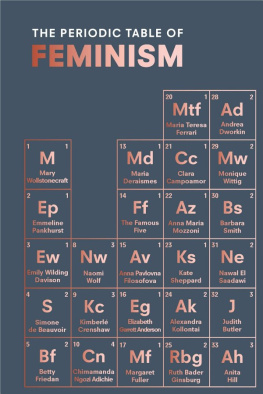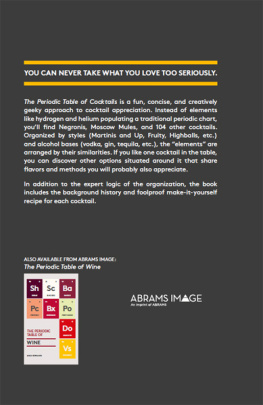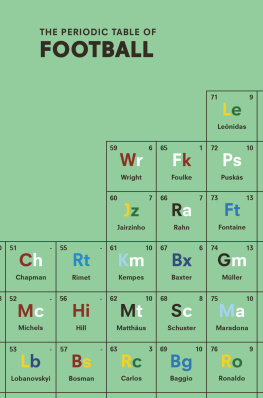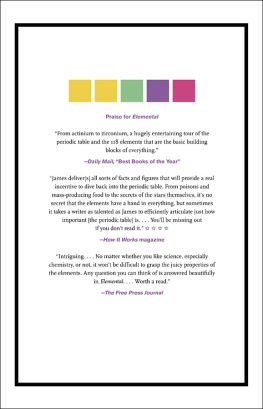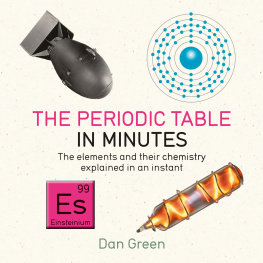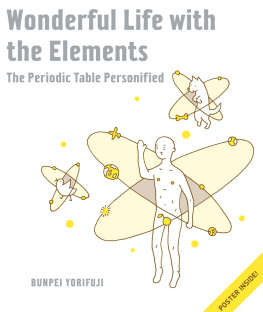MARISA BATE - The Periodic Table of Feminism
Here you can read online MARISA BATE - The Periodic Table of Feminism full text of the book (entire story) in english for free. Download pdf and epub, get meaning, cover and reviews about this ebook. year: 2018, publisher: Pop Press, genre: Romance novel. Description of the work, (preface) as well as reviews are available. Best literature library LitArk.com created for fans of good reading and offers a wide selection of genres:
Romance novel
Science fiction
Adventure
Detective
Science
History
Home and family
Prose
Art
Politics
Computer
Non-fiction
Religion
Business
Children
Humor
Choose a favorite category and find really read worthwhile books. Enjoy immersion in the world of imagination, feel the emotions of the characters or learn something new for yourself, make an fascinating discovery.
- Book:The Periodic Table of Feminism
- Author:
- Publisher:Pop Press
- Genre:
- Year:2018
- Rating:5 / 5
- Favourites:Add to favourites
- Your mark:
- 100
- 1
- 2
- 3
- 4
- 5
The Periodic Table of Feminism: summary, description and annotation
We offer to read an annotation, description, summary or preface (depends on what the author of the book "The Periodic Table of Feminism" wrote himself). If you haven't found the necessary information about the book — write in the comments, we will try to find it.
The Periodic Table of Feminism — read online for free the complete book (whole text) full work
Below is the text of the book, divided by pages. System saving the place of the last page read, allows you to conveniently read the book "The Periodic Table of Feminism" online for free, without having to search again every time where you left off. Put a bookmark, and you can go to the page where you finished reading at any time.
Font size:
Interval:
Bookmark:
Feminism is a political, social and philosophical movement that has transformed and revolutionized womens lives.
From fearless women campaigning for the right to vote, to pioneers in fields of medicine, politics and business by way of pop-culture heroines, writers and creatives, The Periodic Table of Feminism explores the journey of feminism featuring over 100 inspiring and engaging international figures who have helped to shape it.
This is an essential guide to feminism and a place to turn to for courage and inspiration from historys heroic women.
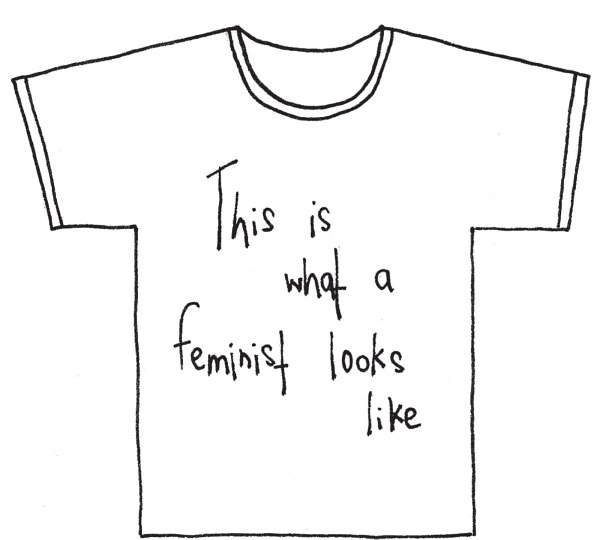
The Periodic Table Series
Periodically, were all geeks about the things we love and the Periodic Table series has been created to celebrate this universal fact.
Inspired by The Periodic Table of Chemical Elements guide you hold in your hands.
Geeky? Absolutely.
Hugely satisfying? Categorically.
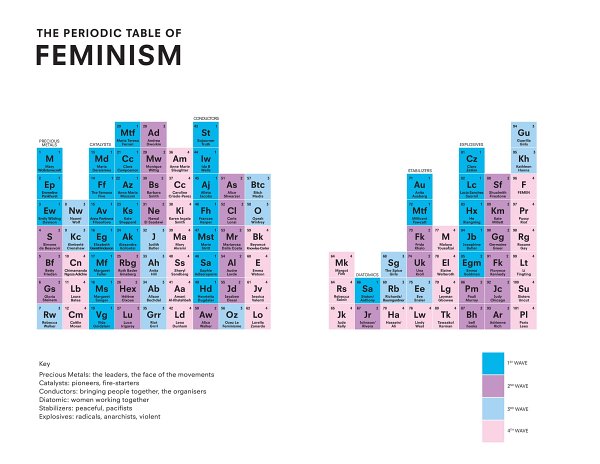
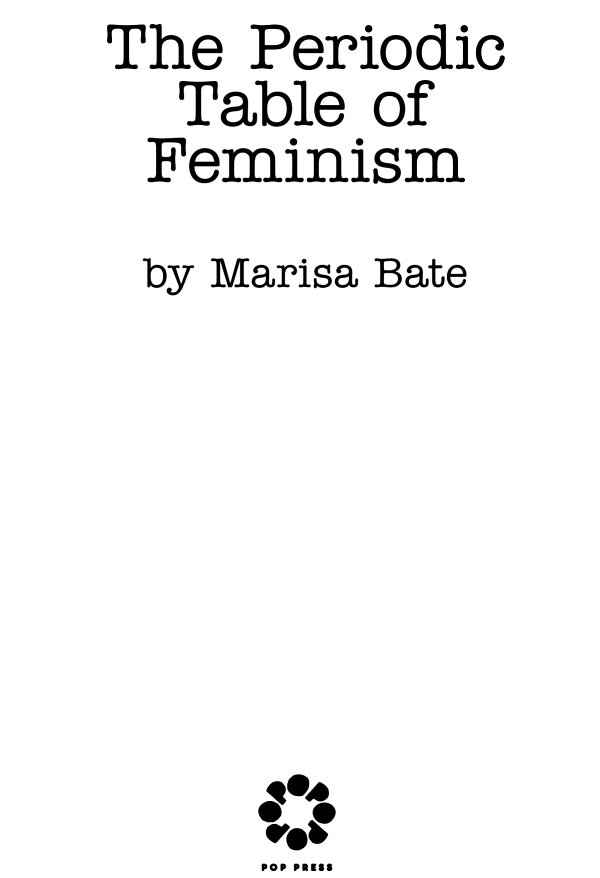
To my mum and Ed - my two favourite feminists.
Feminism is a political, social and philosophical movement that has transformed and revolutionised womens lives. But feminism is also something else, something harder to articulate. It is a feeling in your gut, in your chest, in your eyes when they sting with hot tears or in your quivering voice in a moment of courage. Feminism is a drive, an energy, a constructive anger, an expression of hope for change, that keeps me, you, us, as it has done for millions of others, moving forward. It is a swell of a heart that is prepared to break for the greater good. Feminism is both a movement and something that can profoundly move us.
But how do you tell the story of feminism? Can you do justice to generations who have built and moulded a movement? Can you capture the infinite ways by which women have lived and fought and struggled and won and lost? Can you truly convey where feminism sits in the great political, economic and social narratives of the last one hundred years or so? Ultimately, can you even have a Periodic Table of Feminism?
These are questions I have sincerely grappled with and this is the conclusion I have reached: this is my periodic table one I want to share with as many readers as possible but this is a periodic table that I built. It is categorically not the definitive periodic table of feminism. Because to truly understand feminism is to understand that it is not a singular narrative; it is not a dictatorship of behaviour and opinions. Yes, there is a certain linear narrative; obtaining the vote; entering Parliament; legalising abortion; legislating same-sex marriage. But these are facts that help pin down multiple threads of a movement as diverse and different as women. Feminism is a changeable, shape-shifting, transformative political endeavour to make womens lives better. That mission is the only constant the method, the expression, the arrangement and the organisation is multiple, often conflicting, always hopeful, never perfect.
At the start of this process I had one rule: the women in this book must have actively and deliberately chosen to help other women. There are plenty of women who are feminist icons because of what they have personally achieved and in turn how they inspire the next generation. But in the confines of this book, there had to be boundaries. The women you are about to meet had the intention, the agenda to promote, support and help other women not by the proxy of personal achievement but as the root motivation of their actions.
After centuries of womens stories being intentionally forgotten or deemed unimportant, just shining a light on these womens lives is a feminist exercise in itself. But this table aims to situate those lives within the feminist movement, and also to paint a bigger picture of its place in the world.
Inside the movement, I wanted to track and trace how feminisms objectives transformed over time, from the fight for legal rights and personhood at the turn of the century to the demand for access to abortion, as well as the intellectualisation of the movement in the 1960s and 1970s. I wanted to understand how, as Angela Davis has said, the project of feminism changed from issues of white womens liberation from domesticity and servitude to men to a focus on diversity. I wanted to appreciate how the same movement then gave birth to the anti-academic punk rock rage of Riot Grrrl and the rise of the hashtag warriors of the fourth wave. I wanted to show how, as much as the movement changed, some ideas became foundational. Simone de Beauvoir wrote, One is not born but becomes a woman in 1949. Her words would echo into the future and we find their relevance time and again across the table.
And what about outside the movement the external forces that help change those internal discussions and shape feminism? Enlightenment thinking and the French Revolution prompted Mary Wollstonecraft to write what is considered the bible of western feminism. The suffragette movement was born out of an era of industrialisation and rising belief in the rights of the underclasses. The political patchwork of the 20th century fascism, communism, civil war all played their part in sculpting the fight for womens rights.
So if you want to understand the political and social makeup of a nation, ask women about their lives. Choice, freedom and self-determination are often the stakes at play for women when political extremities take hold, and their presence or absence reveal a bigger story. Clara Campoamor helped write the Spanish Constitution in 1931, and in turn pushed through pioneering feminist legislation, before the arrival of Francos dictatorship forced womens rights to regress. In the 1960s, Marxist factory strikes in northern Italy encouraged women to campaign for wages for housework a movement that then spread across the world. At the same time, the civil rights movement burst through a dam that allowed the womens movements to follow and as we witness racial hostility in America once again in recent times, we remember that three women created Black Lives Matter. I say this to make the point that the womens movement is not an isolated incident, as womens issues are often considered to be; separate, unique only to women. No. Rather, they are the story of a whole society or a whole nation. They reflect who we all are. I wanted to show this movement not only as the actions of brave individuals, but as a river flowing through the heart of history, being carried along by the determination of human endeavour, and carrying others along with it, too.
Of course, there is no way that all the women who deserve their story to be committed to paper could fit in this book. This book spans over 100 years and it would be like trying to fit a Tolstoyan epic into a single tweet. Instead, I hope the women I have chosen help to tell the story of many women like them. After all, we know that behind every great man there is a great woman, but what we should remember is that behind every great woman, theres at a least dozen more. When we do have the privilege of hearing a womans voice we must listen, but we must also keep wondering; whose voice arent we hearing? In light of this I have tried to include the women who are already known heroes but also introduce the lesser-known pioneers. Look out for the Dutch wonder woman Aletta Jacobs and then commit her name to memory. I have also endeavoured to celebrate those fighting oppression and struggles on multiple fronts. As the electrifying Audre Lorde wrote; I am not free while any woman is unfree, even when her shackles are very different from my own It was Kimberl Crenshaw in 1989 who finally gave a name to one of the few things feminism must be: intersectional.
Font size:
Interval:
Bookmark:
Similar books «The Periodic Table of Feminism»
Look at similar books to The Periodic Table of Feminism. We have selected literature similar in name and meaning in the hope of providing readers with more options to find new, interesting, not yet read works.
Discussion, reviews of the book The Periodic Table of Feminism and just readers' own opinions. Leave your comments, write what you think about the work, its meaning or the main characters. Specify what exactly you liked and what you didn't like, and why you think so.

